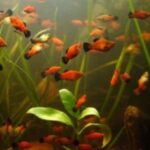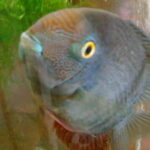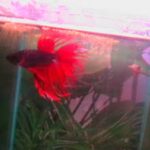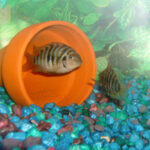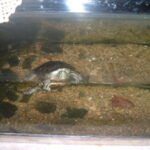I am happy to say that I have 5 aquariums with African Cichlids. In them you will find all of the different stages in their developmental life. From babies (fry) to full grown males and females.
I knew very little about African Cichlids before my husband and I started the adventure of buying our first aquarium, my husband on the other hand had been raised with African Cichlids aquariums all over his parents’ house.
The first thing to know is that African Cichlids are fresh water tropical fishes. You need to be very careful checking and maintaining the temperature of the water and the PH level. You would need to start a 20 or 40 gallon tank, depending on how many African Cichlids you want to start with, canister filter, heater, plants (plastic ones would be easier at first) rocks and gravel.
When choosing a tank have in mind that African Cichlids prefer length more than height, so an aquarium that is wider and longer would be prefer over a taller one. Also remember to get enough gravel to bury the decorations, rocks and plants, because African Cichlids are diggers and they will enjoy digging on the gravel and it will be dangerous if one of your rocks fall on top of them.
African Cichlids are highly entertaining, and have great personalities. They like to build homes, dig in the gravel, and entertain themselves by swimming against the water coming from the filter or next to the bubbles. They can also be very territorial. That is why when selecting your African Cichlids you should go to a Fish Store where they can advice you which African Cichlids can be in the same aquarium together, because their level of aggressiveness varies with the difference sub groupings depending on the lake they come from.
I would suggest starting with 1″ to 2″ fishes. It is less expensive and more fun to actually see them grow and develop their personalities. Your first batch should be of 5 fishes and then wait about two weeks and add 5 more depending on the size of your aquarium. A good rule of thumb is that you need a gallon of water for every inch the fish will be when fully grown. If you have many African Cichlids cramp into a small aquarium then they will stop growing.
You should set up the tank at least 10 days before bringing the African Cichlids home. Once you get home introduce the bag sealed in the tank so the fishes get use to the temperature of the water and add a teaspoon of your aquarium water to the bag so they get use to the PH. After about 10 minutes add another teaspoon and after another 10 minutes your fishes should be ready to be located on your aquarium. Remember discard the water from the bag; do not use it in your aquarium.
You will have to make water changes every 10 days approximately. You would use a siphon to drain 10 % of the water trying to get as much waste as possible out of the gravel. Once you have drained 10% of water, you will add new water. This water can be tap water that has been treated with water conditioner. This water conditioner will get rid of the chlorine in the water and help balance the PH.
Once a month you will have to do an in depth cleaning, which means cleaning the filter, rearranging the decorations, which also helps if some of your Africans is being particularly extra territorial, and general maintenance of the tank.
Also make sure and get a small 5 gallon tank, this will act as your nursery in case your Africans have babies, one of them is being bullied by all the rest, or if one of them needs a time out. You don’t have to have it set at all times, just make sure and use water from your running aquarium when you start it and let it run for an hour before you put any fish in it.
African Cichlids food is not expensive and easy to feed. For the smallest we use flakes and for the biggest ones pellets, they also love krill and they will literally eat it from your hand once they have tasted it once.
The most important part is to be committed and understand that you will have to put time and effort for these fishes to be healthy, but they are worth it. Just have fun and enjoy watching them, I know I do.
